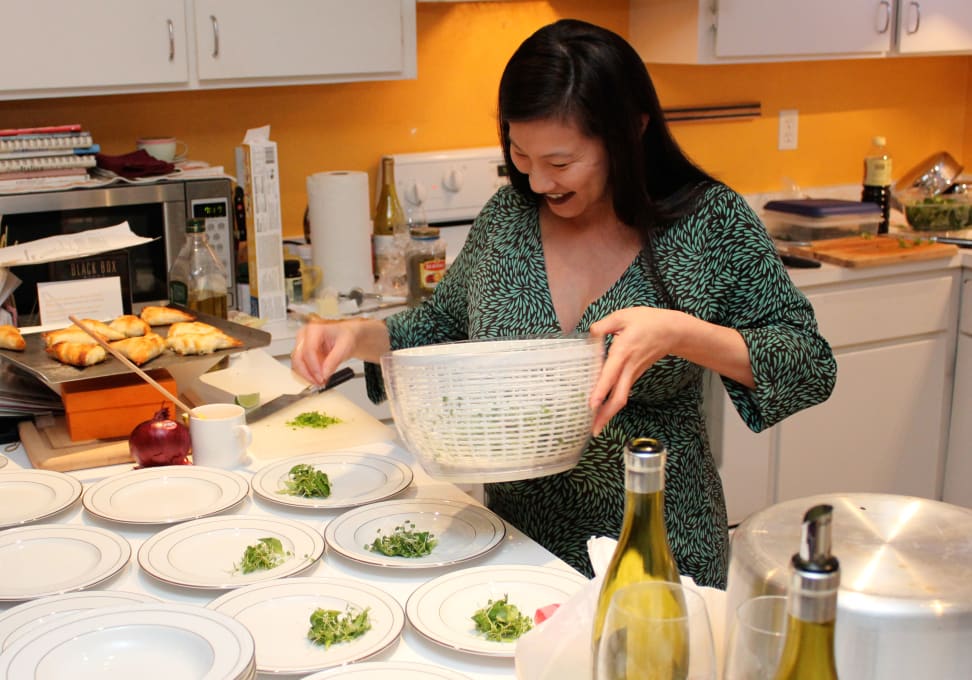 Credit:
Credit:
Products are chosen independently by our editors. Purchases made through our links may earn us a commission.
These days, dinner parties are a minefield of allergies, sensitivities, and specialized diets. It can be especially difficult to accommodate everyone’s needs at major holiday meals, like Thanksgiving and Christmas.
If your brother has Celiac disease and a taste for turkey, do you have to give up in-bird stuffing? Is pie or cake out of the question for your vegan sister or lactose-intolerant Aunt Janet?
If you don’t have an intimate knowledge of food substitutions, planning can feel a bit like assembling a complex jigsaw puzzle in the dark. But we’re here to help: We've prepared a cheat sheet to help you satisfy everyone at the dinner table. Time to get cooking!
The Gluten-Free Guest
Celiacs and those with lesser gluten sensitivities are tricky—even a tiny speck of airborne flour can cause gastrointestinal misery.
It goes without saying that you should be careful when you’re cooking, but don't despair: You can still serve a big platter of biscuits as long as you keep all wheat, rye, barley, spelt, and other gluten-containing ingredients away from “safe” dishes during prep.

Many gluten-free versions of common foods can be purchased at the grocery store, from graham cracker crumbs to pasta. [Image credit: Flickr user "ilovememphis" (CC BY-ND 2.0)]
If you want to alter traditional recipes to suit your gluten-free guest, there are lots of gluten-free recipe blogs with all kinds of recipes. In particular, we like Gluten-Free Girl, Gluten-Free Goddess, and Gluten-Free on a Shoestring.
But if you'd prefer something easier, check your local grocer’s freezer section for gluten-free pie crusts and breads, which can actually be pretty tasty these days. Believe it or not, gluten-free bread can actually be the foundation for a stuffing everyone can enjoy.
Outside the freezer section, you can also purchase handy items like gluten-free pasta or graham cracker crumbs for use in your recipes. And instead of thickening soups and gravies with flour, consider using a small amount of potato starch. Unlike corn starch, it doesn’t need to be cooked off.

Frozen gluten-free pie crusts are often available at the grocery store. [Image credit: Flickr user "dongkwan" (CC BY-ND 2.0)]
Cakes, cookies, and other gluten-heavy baked goods are more difficult to make without gluten. Simply substituting a gluten-free flour or flour mix for wheat flour can be risky, since it behaves differently and the results can be unpredictable.
The safest bet is to use a gluten-free recipe or boxed mix from the start, but if you’re dead set on using an old family recipe, you can give the aforementioned gluten-free flour mixes a try (we like King Arthur Flour’s Gluten-Free All-Purpose Flour mix). Still, there's no guarantee of deliciousness if you go down that road.
The Dairy-Free Diner
Lactose-intolerant guests probably won't have be as susceptible to cross-contamination as Celiacs (though you should check to be sure). That makes your prep a lot easier. In fact, we think you’ll find cooking dairy-free is simpler than you'd expect.
There are plenty of dairy milk substitutes—soy, almond, rice, and coconut—and most are quite common on supermarket shelves. If you're baking, any of these options will do the trick in most cases. We like almond milk for most baking scenarios; rice milk tends to be rather thin, soy milk can trigger allergies, and coconut milk has a bit too much flavor.
Almond milk's mild taste works in everything from muffins to frostings, but read the label carefully: Many brands include added sugar or vanilla flavoring, so you may need to adjust your recipe if it calls for sweetener or vanilla.
Milk subs don’t have to feel like a sacrifice, either. How about using milk made from hazelnuts in your chocolate cake? Tell us that doesn’t sound decadent.

Coconut cream can be whipped as a whipped cream substitute. [Image credit: Flickr user "cpchen" (CC BY-NC-ND 2.0)]
In place of butter, we’d suggest margarine or oil. Stick margarine is a good bet when you’re looking to add some butter-like flavoring or need a fat that solidifies when cooled—as in pie crust or cookie dough. Doughs that are meant to be wetter (like cake dough) can use vegetable or canola oil in place of butter. Olive oil is a good option for a few tablespoons of butter in a soup or sauce, and healthier as well.
When it comes to cream substitutions, canned coconut cream is your best friend. But if you can only find coconut milk, don't worry. You can extract the cream yourself by putting a can of full-fat coconut milk in the fridge to chill, opening it without shaking, and scooping the semi-solid cream off the top.
Once you've got your cream, you can whip it with sugar to make dairy-free whipped cream, or use it in place of regular cream in baked goods. Of course, this may add a slight coconut flavor to your food. For that reason, we don't recommend it in place of cream in savory dishes.
The Egg-Free Eater
Some folks like a good tofu scramble, and more power to them. Still, the first thing you should know when attempting eggless cooking is that any dish that depends entirely on eggs (scrambled eggs, frittatas, quiches) should probably be left alone. Eggs are simply the only way to make something taste authentically eggy.
Baking, however, is a different story. Many grocery stores carry commercial egg replacers in powder form. (The EnerG brand is especially popular.) If you’d rather avoid such a specialized purchase, Eggless Cooking provides a handy chart listing many alternative ingredients you probably already have on-hand.
If the egg is meant to provide moisture, you can sub in any liquid that will mesh well with other flavors, including water. Eggs that provide leavening can be replaced by anything from buttermilk to baking soda. Ingredients like silken tofu and unflavored gelatin (or its vegetarian version, agar) can stand in for eggs as a binding solution.
If you’re eschewing eggs out of respect for vegan dinner guests, make sure to sub for dairy as well. (And, of course, skip any meat.)
The Soy Spurner
Many people with soy allergies are able to consume very small amounts of soy (such as the amount found in soybean oil or soy lecithin), so it’s in your best interest to find where the soy spurner at your dinner table falls on the allergy spectrum. Many commercial food products include these ingredients (including some you wouldn't necessarily expect), so it can drastically affect which ingredients you can use in your dishes.
That said, cooking without soy is a cinch as long as you read labels carefully. Soy sauce is off-limits, but small amounts of soy-free miso or fish sauce can provide that salty umami flavor to your food. (Go easy on the fish sauce, though—a little goes a long way.) Coconut aminos are another great soy sauce substitute.

Be careful when adding fish sauce—a little goes a long way! . [Image credit: Flickr user "mr_wood" (CC BY-NC-ND 2.0)]
Most miso is made from fermented soybeans, but other kinds are available. We’re rather partial to South River Miso’s Chickpea Miso, which has a chunkier texture complete with bits of chickpeas and rice. Tofu or soy-based fake meat products are definitely not safe, so if you’re cooking for a vegetarian or vegan, we’d recommend you stick to beans or veggies.
Tips & Tricks for the Host
Communication is by far the most important aspect of cooking for eaters with food restrictions. Sure, it’s kind of a pain, but it’s in everyone’s best interest that you don’t wind up poisoning your guests. Ask each person what’s safe and what’s not, and run recipes by them to be sure. Chances are, they know better than you do what they can and can't eat.
You certainly aren’t required to make every dish on the table allergy-friendly. If there’s something a guest can't eat, just make sure they’re aware before the meal begins.
If accommodating a special diet seems too difficult, you can ask guests with allergies or other issues to bring dishes they can eat. Many people with unusual diets understand that allergen-free cooking can be a lot of work, and are happy to help out.
Hero image: Flickr user "lancejohnson" (CC BY-NC 2.0)
